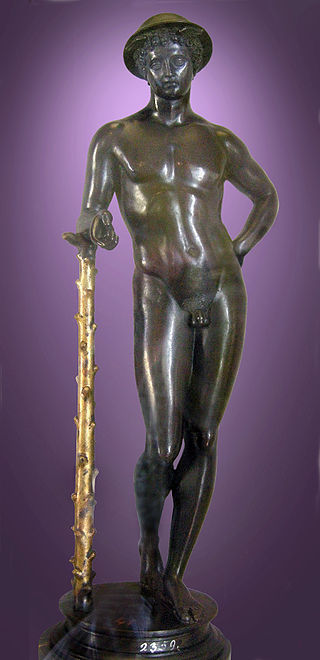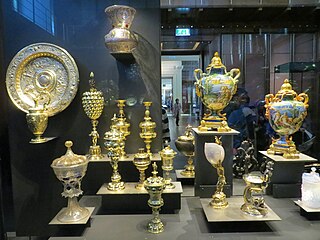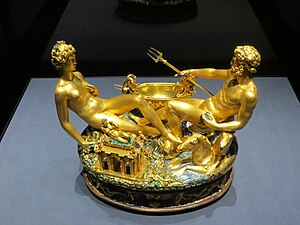
Benvenuto Cellini was an Italian goldsmith, sculptor, and author. His best-known extant works include the Cellini Salt Cellar, the sculpture of Perseus with the Head of Medusa, and his autobiography, which has been described as "one of the most important documents of the 16th century".

The Villa d'Este is a 16th-century villa in Tivoli, near Rome, famous for its terraced hillside Italian Renaissance garden and especially for its profusion of fountains. It is now an Italian state museum, and is listed as a UNESCO World Heritage Site.

In art history, the French term objet d’art describes an ornamental work of art, and the term objets d’art describes a range of works of art, usually small and three-dimensional, made of high-quality materials, and a finely-rendered finish that emphasises the aesthetics of the artefact. Artists create and produce objets d’art in the fields of the decorative arts and metalwork, porcelain and vitreous enamel; figurines, plaquettes, and engraved gems; ivory carvings and semi-precious hardstone carvings; tapestries, antiques, and antiquities; and books with fine bookbinding.

The Kunsthistorisches Museum is an art museum in Vienna, Austria. Housed in its festive palatial building on the Vienna Ring Road, it is crowned with an octagonal dome. The term Kunsthistorisches Museum applies to both the institution and the main building. It is the largest art museum in the country and one of the most important museums worldwide.
The year 2003 in art involves various significant events.

The Loggia dei Lanzi, also called the Loggia della Signoria, is a building on a corner of the Piazza della Signoria in Florence, Italy, adjoining the Uffizi Gallery. It consists of wide arches open to the street. The arches rest on clustered pilasters with Corinthian capitals. The wide arches appealed so much to the Florentines that Michelangelo proposed that they should be continued all around the Piazza della Signoria.

Pier Jacopo Alari Bonacolsi, called L'Antico by his contemporaries, and often Antico in English, the nickname given for the refined interpretation of the Antique they recognized in his work, was a 15th- and 16th-century Italian Renaissance sculptor, known for his finely detailed small bronzes all'Antica—coolly classicizing, often with gilded details, and silver-inlaid eyes, a refinement that is found in some classical and Hellenistic Greek bronzes.

Boy with Thorn, also called Fedele (Fedelino) or Spinario, is a Greco-Roman Hellenistic bronze sculpture of a boy withdrawing a thorn from the sole of his foot, now in the Palazzo dei Conservatori, Rome. There is a Roman marble version of this subject from the Medici collections in a corridor of the Uffizi Gallery, Florence.

Johann Melchior Dinglinger was one of Europe's greatest goldsmiths, whose major works for the elector of Saxony, Augustus the Strong, survived in the Grünes Gewölbe, Dresden. Dinglinger was the last goldsmith to work on the grand scale of Benvenuto Cellini and Wenzel Jamnitzer, fewer of whose large-scale works in precious materials have survived, however. His work carries on in a Mannerist tradition into the "Age of Rococo".
The Rospigliosi Cup, sometimes referred to as the Cellini Cup, is a decorative ornament in gold and enamel, previously attributed to Benvenuto Cellini (1500–1571), but now known to be an art forgery, of nineteenth-century manufacture.

Ronde-bosse, en ronde bosse or encrusted enamel is an enamelling technique developed in France in the late 14th century that produces small three-dimensional figures, or reliefs, largely or entirely covered in enamel. The new method involved the partial concealment of the underlying gold, or sometimes silver, from which the figure was formed. It differs from older techniques which all produced only enamel on a flat or curved surface, and mostly, like champlevé, normally used non-precious metals, such as copper, which were gilded to look like gold. In the technique of enamel en ronde-bosse small figures are created in gold or silver and their surfaces lightly roughened to provide a key for the enamel, which is applied as a paste and fired. In places the framework may only be wire.

Northern Mannerism is the form of Mannerism found in the visual arts north of the Alps in the 16th and early 17th centuries. Styles largely derived from Italian Mannerism were found in the Netherlands and elsewhere from around the mid-century, especially Mannerist ornament in architecture; this article concentrates on those times and places where Northern Mannerism generated its most original and distinctive work.

The Holy Thorn Reliquary was probably created in the 1390s in Paris for John, Duke of Berry, to house a relic of the Crown of Thorns. The reliquary was bequeathed to the British Museum in 1898 by Ferdinand de Rothschild as part of the Waddesdon Bequest. It is one of a small number of major goldsmiths' works or joyaux that survive from the extravagant world of the courts of the Valois royal family around 1400. It is made of gold, lavishly decorated with jewels and pearls, and uses the technique of enamelling en ronde bosse, or "in the round", which had been recently developed when the reliquary was made, to create a total of 28 three-dimensional figures, mostly in white enamel.

In 1898 Baron Ferdinand de Rothschild bequeathed to the British Museum as the Waddesdon Bequest the contents from his New Smoking Room at Waddesdon Manor. This consisted of a wide-ranging collection of almost 300 objets d'art et de vertu, which included exquisite examples of jewellery, plate, enamel, carvings, glass and maiolica. One of the earlier objects is the outstanding Holy Thorn Reliquary, probably created in the 1390s in Paris for John, Duke of Berry. The collection is in the tradition of a schatzkammer, or treasure house, such as those formed by the Renaissance princes of Europe; indeed, the majority of the objects are from late Renaissance Europe, although there are several important medieval pieces, and outliers from classical antiquity and medieval Syria.

Dionysio Miseroni von Lison was a Bohemian-Italian jeweler, gemcutter, and glass cutter. He was a member of very famous Miseroni family who were important jewelers and gemcutters from Milan: the archive information for the Milanese Miseroni family dates back to the 15th century, when there is traces, in 1453, of Giovanni Francesco or Francesco, son of Gasparo, mentioned in 1460 as a member of the goldsmiths' guild, of which he was appointed consul in 1468 and 1475, and abbas in 1480 and again in 1488.
Sidney John Alexander Churchill, often referred to as Sidney J. A. Churchill, was a British diplomat, art connoisseur and author.

Reinhold Vasters was a German goldsmith. When a collection of his designs came to light some 60 years after his death, it became apparent that he had been a prolific art forger.

The Parade Armour of Henry II of France, now in the Metropolitan Museum of Art, New York, is believed to date from c 1553–55 and its decoration is attributed to the French goldsmith and engraver Étienne Delaune. Designed for use in pageantry, the armour was fashioned of gold, silver and steel and with leather and red velvet trimmings. It was created for Henry II of France as ceremonial wear; the figures embossed on the breastplate and back are intended to reflect his military achievements.
There are several portraits of the Italian goldsmith and sculptor Benvenuto Cellini (1500–1570). Including self-portraits and portraits of him by other artists. Benvenuto Cellini's physical appearance is determined based on a number of his lifetime portraits. However, due to a few known portraits from the 17th – 20th century, where the artists drew Cellini's facial traits from their imagination, as well as because of past posthumous erroneous attributions, there is a level of confusion on this subject.

The Nymph of Fontainebleau, also known as the Nymph of Anet or the Nymph with the Stag, is a c.‑1543 bronze relief, created by the Italian sculptor Benvenuto Cellini for the Château de Fontainebleau in France. It features a long-limbed reclining nude female nymph with a stag, wild boars, dogs, and other animals. It was Cellini's first large scale bronze casting.

















